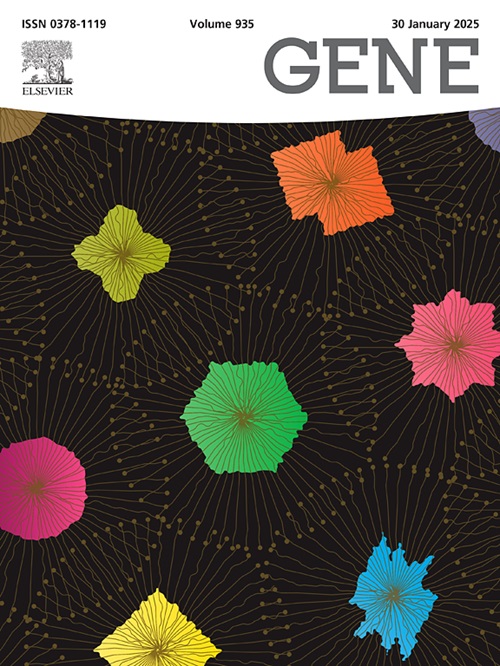Nimbolide通过调节miRNAs 21,145和221及其靶基因表达来减轻肝细胞癌。
IF 2.6
3区 生物学
Q2 GENETICS & HEREDITY
引用次数: 0
摘要
背景和目的:从病因学和治疗的角度来看,MicroRNAs (miRNAs)在癌症研究中逐渐出现。一些mirna作为癌基因或肿瘤抑制因子,在许多癌症中失调。我们之前的研究已经证实,楝树内酯(一种从楝树中提取的生物活性萜类物质)通过多种机制减轻小鼠肝细胞癌(HCC)。在这里,我们旨在阐明nimbolide在调节HCC小鼠中参与促进炎症和癌细胞增殖的特异性mirna(21、145和221)及其靶基因中的作用。方法:小鼠肝癌诱导28 周后,连续4周口服nimbolide(6 mg/kg b.wt.)。结果:我们发现HCC小鼠肝脏中miR-21a-3p、miR-21a-5p、miR-221-5p和miR-221-3p的表达显著升高,miR-145a-5p的表达显著降低。Nimbolide治疗HCC小鼠可显著降低miR-21a-5p和miR-221-3p,提高miR-145a-5p基因表达。我们的计算机研究也支持这些发现。此外,肝紧密连接(TJ)相关蛋白如claudin 1和5 mRNA和蛋白的表达显著增加,而肝claudin 2 mRNA和蛋白的表达显著降低。Nimbolide还能调节HCC小鼠中cadherins、rock1、mmp9、cyclin D1、CDK4、NF κB和TNFα mRNA的表达。结论:我们首次发现尼布莫利特治疗HCC小鼠可显著降低肝脏miRNAs 21和221的表达,并保护miR-145的表达。这些发现在计算机研究中得到进一步证实。此外,尼布莫利特治疗HCC小鼠可调节参与癌细胞增殖和炎症的miRNA靶基因,从而减缓小鼠HCC的进展。本文章由计算机程序翻译,如有差异,请以英文原文为准。
Nimbolide attenuates hepatocellular carcinoma by regulating miRNAs 21, 145 and 221 and their target gene expression
Background and aims
MicroRNAs (miRNAs) are becoming progressively emerging in cancer research from an etiologic and curative point of view. Several miRNAs act as oncogenes or tumor suppressors, which are dysregulated in numerous cancers. Our previous studies have established that nimbolide (a bioactive terpenoid from neem) attenuated hepatocellular carcinoma (HCC) through various mechanisms in mice. Here, we aimed to elucidate the effect of nimbolide in modulating specific miRNAs (21, 145, and 221) and their target genes involved in promoting inflammation and cancer cell proliferation in HCC mice.
Methods
Following the induction of HCC in mice at 28 weeks, nimbolide (6 mg/kg b.wt.) was administered orally for four consecutive weeks.
Results
We found significantly increased hepatic expression of miR-21a-3p, miR-21a-5p, miR-221-5p and miR-221-3p whilst significantly decreased miR-145a-5p in HCC mice. Nimbolide treatment to HCC mice substantially reduced the miR-21a-5p and miR-221-3p and improved miR-145a-5p gene expression. Our in-silico study also supports these findings. Moreover, hepatic tight junction (TJ) associated proteins such as claudins 1&5 mRNA and protein were increased considerably, whilst significantly decreased hepatic claudin 2 mRNA and protein expression noted in HCC mice. Nimbolide also regulates cadherins, ROCK 1, MMP 9, cyclin D1, CDK4, NF κB and TNFα mRNA expression in HCC mice.
Conclusion
We identified for the first time that nibmolide treatment to HCC mice significantly attenuated hepatic miRNAs 21 & 221 expressions and sheltered miR-145 expression. These findings were further confirmed with in-silico studies. Moreover, nibmolide treatment in HCC mice regulates miRNA target genes involved in cancer cell proliferation and inflammation, thereby attenuating HCC progression in mice.
求助全文
通过发布文献求助,成功后即可免费获取论文全文。
去求助
来源期刊

Gene
生物-遗传学
CiteScore
6.10
自引率
2.90%
发文量
718
审稿时长
42 days
期刊介绍:
Gene publishes papers that focus on the regulation, expression, function and evolution of genes in all biological contexts, including all prokaryotic and eukaryotic organisms, as well as viruses.
 求助内容:
求助内容: 应助结果提醒方式:
应助结果提醒方式:


